| Estate Landscaping and Greening | Water | Air | |||||
| Noise | Energy | Waste | |||||
| Control of Hazardous Materials | Material Usage | Compliance | |||||
| Case Study: Microclimate Studies |
We conduct our operations with consideration for their environmental impacts. Our responsibility for the environment ranges from the construction, maintenance, and operation of our facilities, to the conservation of natural resources.
In an effort to maintain a leading role in protecting the environment, we continually seek opportunities to improve environmental performance. To improve our environmental performance throughout the year, performance targets were set in 2006/07. We have been constantly reviewing these targets while addressing any new issues of concern.
Estate Landscaping and Greening
Enhancing the comfort and quality of public housing estates as well as their surrounding environment has been one of our continuous priorities. The uniquely compact environment in Hong Kong has posed a challenge of providing aesthetic and healthy surroundings for residents. As a result, we have continued to actively resolve the challenges ahead.
In 2006/07, our landscape architects and Horticultural Team continued their efforts to improve the living environment in our estates through the planting of about 5 300 trees, 587 200 shrubs and
51 600 annuals.
Greening and Landscaping Targets for period 2006/07 |
Performance |
Provide green treatment to newly formed slopes. |
Fully Met |
Improve the slope appearance in existing Public Rental Housing (PRH) estates. |
Fully Met |
Add new vegetation and promote greening in new housing estates to meet the minimum target of 1 tree per 15 PRH flats. Conduct tree surveys to ensure that this is met. |
Fully Met |
Upgrade the existing landscape in 18 selected PRH estates by improving soft landscaping through the Landscape Improvement Programme. |
Fully Met |
Enhance greening in PRH estates by allocating open areas in selected estates for setting up theme gardens. |
Fully Met |
Promote green environment at 24 estates with Estate Management Advisory Committees (EMACs) through the provision of green activities in these estates. |
Fully Met |
Vertical Landscaping and Greening
A new attempt to establish a pilot vertical green panel system on the external wall of buildings is underway in Phase 4 in Eastern Harbour Crossing Site. Consisting of modular prefabricated external cladding panels that can be moved around, they act as 'trellises', allowing plants to grow on them while providing a green environment and acting as heat insulators as well as noise and dust barriers. The modulated and prefabricated panels enable easy on-site installation and future maintenance work. Trial panels have been installed on site during the construction stage and to be relocated to their permanent location upon project completion.
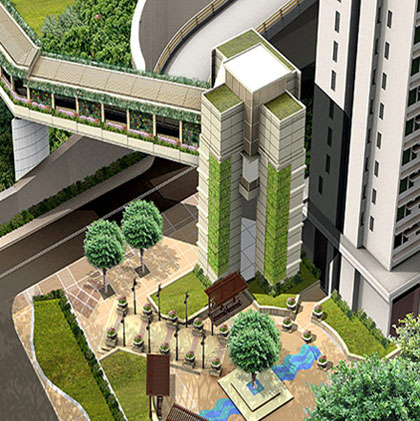 |
|
| Eastern Harbour Crossing Phase 4 Fitted with Vertical Green Panels (under construction) | |
Thematic Gardens
In 2006/07, the persistent efforts of the Horticulture Team have finally been paid off by the establishment of two thematic gardens, namely, the Anti-mosquito Planting Strip at Sun Chui Estate and the Fruit Garden at Tai Hing Estate.
Attesting to the experience and expertise gained in these activities over the years, our 'Garden of Felicity' display, based on the theme 'Cherishing the Family', won the Gold Award for Design Excellence (Landscape Display) in the 2007 Hong Kong Flower Show organised by the Leisure and Cultural Services Department.
Roof Top Planting and Slope Greening
In order to maximise the available space for enhancing greenery, we have continued to plant vegetation on podium roofs of shopping centres, car parks and low-rise buildings. Major landscape improvement works were conducted by our Horticultural Team in 18 estates including the upgrading of 110 000 m2 of greenery. In the past year, green treatment was provided to
350 m2 of slope area. Improvement to slope appearance has also been carried out at eight estates.
Greening Activities
In addition, greening improvement activities for 5 000 m2 were carried out in 24 estates through the EMACs.
Apart from landscaping and greening of housing estate areas, the Horticulture Team also provides basic horticultural and arboricultural training courses to estate frontline staff, as well as promoting greening activities and enhancing residents' awareness of environmental protection. In addition to the efforts by the Horticulture Team, local communities have also been encouraged to participate in planting seedlings in 14 housing estates (See Stakeholder Engagement section for details).
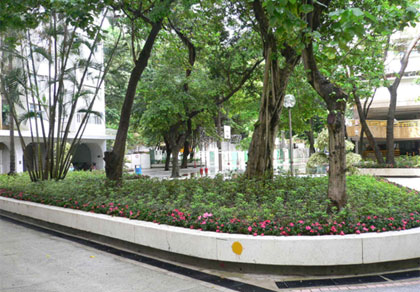 |
|
| Landscape Improvement in Chun Shek Estate | |
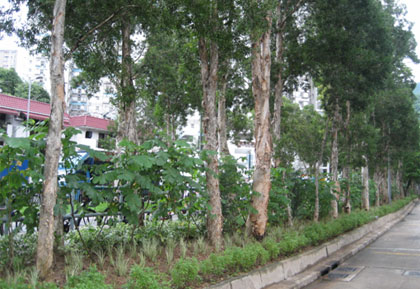 |
|
| Landscape Improvement in Sun Chui Estate | |
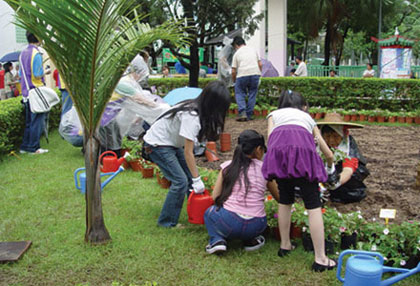 |
|
| School Children Participated in Landscape Improvement in an Estate | |
Managing the drinking water quality and a reliable water supply for Public Rental Housing (PRH) estate residents is paramount to ensuring the safety of water supplies. Therefore, we keep our water supply systems in top condition through preventive maintenance and good services.
We are always seeking opportunities to reduce our water consumption both through raising awareness and through various water saving technologies built into our operations.
Water Conservation Targets for period 2006/07 |
Performance |
Reduce flushing water consumption by conducting trial schemes in new projects. |
Fully Met |
Reduce potable water consumption for installations under landlord control in PRH estates. |
Fully Met |
Enhance efficient potable water usage in shopping centres by installing self-stopping or movement-sensing water taps during toilets upgrading. |
Fully Met |
Record and monitor water consumption at the Housing Authority headquarters (HAHQs) in meeting the target of water consumption to less than that of 2005/06. |
Fully Met |
Fresh Water Quality Scheme
In 2003, a Fresh Water Plumbing Quality Maintenance Recognition Scheme was launched by the Water Supplies Department, to ensure the continuing quality of potable water in our buildings. This requires regular monitoring of water supplies in buildings and by the end of March 2007,
1 015 blocks in 148 estates had been certified under the Fresh Water Quality Scheme.
Protecting Potable Water Quality
To safeguard the potable water quality and to tackle the effects of water discoloration due to deteriorated steel pipes, we continue to carry out our ongoing programme of replacing the original galvanized steel pipes with copper or unplasticised polyvinyl chloride (uPVC)-lined steel pipes. This is a 13-year plumbing programme, first initiated in 1996/97. In 2006/07, fresh water pipes in 60 blocks were replaced at a cost of HK$96 million. This brings our total number of housing blocks with replacement of water pipes to 800 by the end of March 2007.
Water Savings
Reducing water use and water wastage in our estates is a constant priority and challenge. Our long-term goal is to prevent water wastage by improving operational efficiencies and advancing new technologies. That is why we combine a series of best practices that conserve water, use technology throughout our construction and maintenance programmes, and inform our tenants of water saving tips.
To reduce potable water consumption, self-stopping water taps have been installed. A replumbing programme is also in place to reduce the incidence of pipe bursting and leakage. A reduction of 6.17% of potable water consumption against 2005/06 was achieved by the end of March 2007 due to the installation of water saving systems by landlords in PRH estates.
It is now a mandatory requirement for our contractors to implement Water Recycling Systems for all projects involving Large Diameter Bored Piling Works as well as the construction of new buildings, piling and civil engineering projects. During the year 2006/2007, Water Recycling Systems have been implemented in 21 building contracts, resulting in approximately 12% of water saving. In addition, two ground investigation contracts are implementing recycling of flushing water which has resulted in total water saving of 11 300 m3.
Water Related Complaints
In 2006/2007, we received two water related complaints on our contractors due to the cement contaminated water leaking from construction sites. These complaints have been followed up by the contractors and closed.
We continue to incorporate measures to reduce any air quality impact caused by our operations, particularly during the construction of Public Rental Housing (PRH) estates.
The major air quality impact caused by the construction and demolition works is the emission of dust. The Housing Authority (HA) requires all of its contractors to implement all practicable means to avoid or control dust and exhaust emissions from construction materials, equipment and vehicles. In addition, we continue to apply the pre-casting and prefabrication technology and have recently introduced the "hard-paved construction" arrangements at all building and piling sites.
Reducing Dust Impacts at Construction Sites
In order to further reduce the air quality impact posed by our construction works, in 2005 we introduced "hard-paved construction" at all our building and piling sites. The practice uses precast concrete slabs or other materials to provide hard paving at the construction sites, thus reducing the accumulation of mud, and therefore dust by the wind and carried by the wheels of vehicles to the vicinity surrounding the sites. Hard paving also facilitate site drainage and enables efficient delivery and storage of building materials. All Piling and Building Works are benefiting from this practice.
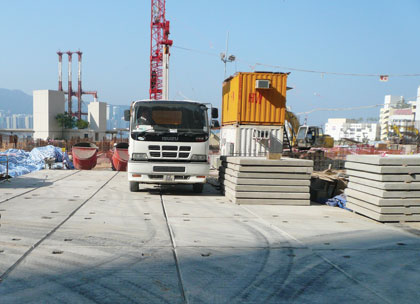 |
|
| Hard Paved Construction at One of Our Construction Sites | |
Odour Control at Refuse Collection Points
The HA has training programmes and policies in place to ensure the proper management of refuse collection in the PRH estates. From construction to estate management, these procedures are integrated throughout our operations. By the end of March 2007, 20 packaged deodorizers had been installed in refuse collection points in the buildings to help control odours and prevent nuisance to residents and staff. ![]()
No Use of Ozone Depleting Chemicals
To comply with the Government's regulation on the ban of the use of ozone depleting chemicals, none of our air conditioning units or chillers use chlorofluorocarbons (CFCs). Our fire extinguishers are also free of halogen gas. Our environmental procurement policy also stipulates no ozone depleting chemicals are to be used in the building materials that we use in new works and maintenance contracts.
Regional Atmospheric Pollution and Climate Change
To address concerns on regional air pollution and global climate change, we are actively engaged in finding ways to reduce our energy consumption and carbon footprint. We are an avid advocate of the Action Blue Sky Campaign of the Government launched in July 2006. As new fuel efficient and alternative technologies become widely available and affordable, the HA's long-term goal is to decrease total carbon dioxide emissions produced by our operations. Currently, our efforts are focused on the following measures:
- Using both local and international standards on the use of CFC-free equipment and the implementation of best practices to reduce dust and air emissions;
- Publishing information on energy consumption (See Energy section);
- Adopting energy efficiency measures in our housing designs in accordance with the Building Energy Codes promulgated by the Hong Kong Electrical and Mechanical Services Department and exploring measures to increase the application of renewable energy; and
- Sharing our experience and knowledge of air pollution reduction measures at both local and international levels through conferences and seminars.
Air and Dust Complaints
In 2006/2007, we received three dust complaints and two odour complaints on our contractors. The dust complaints were related to construction site operations and the odour complaints were associated with renovation works. All these complaints have been followed up by the contractors and closed out.
This year, we continue to implement measure to the reduce noise impact of our operations, mostly from construction sites and from water pumps in Public Rental Housing (PRH) estates. The use of precasting and prefabrication technology not only reduces air pollution but has also reduced the amount of mechanical equipment used on site and therefore the cumulative noise impact.
Noise Targets 2006/07 |
Performance |
Reduce noise nuisance from water pumps in PRH estates by replacing 3 000 rpm water pumps with 1 500 rpm water pumps. |
Fully Met |
Reducing Noise at Construction Sites
The innovative technology for precast facades, staircases and semi-precast slabs, first used by the Housing Authority in the 1980s, was expanded in our pilot project at Kwai Chung by increasing the extent of use of precast concrete in building works. The construction of the superstructure of the Kwai Chung Flatted Factory, completed in early 2007, has employed precasting and prefabrication technology for 60% of the concrete works. The increased use of precast concrete is expected to reduce the impact on air quality, noise and waste as well as provide safer and cleaner sites for workers.
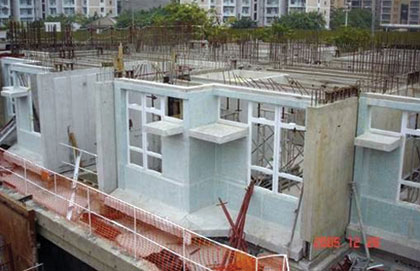 |
|
| Advanced Pre-cast Technology Adopted for Kwai Chung Flatted Factory | |
Hydraulic concrete crushers, as opposed to percussive breakers, could now be specified for use in our demolition projects, which could significantly lessen construction noise levels. We have also implemented the guidelines for noise-sensitive construction sites.
Water Pump Replacement
In 2006/07, 16 high speed pumps in PRH estates were replaced with low-noise, low speed pumps to cut noise levels.
Noise Complaints and Abatement Notices
In 2006/2007, we received nine noise complaints, four of which were related to construction works. The number of noise complaints against construction sites has therefore decreased, representing a decreasing trend for the past five years. Other noise complaints were related to renovation, maintenance and repair works. In the same period, no noise abatement notices were issued to the public housing estates by the Environmental Protection Department. All these complaints have been followed up by the contractors and closed out.
Number of Noise Complaints Against Construction Sites
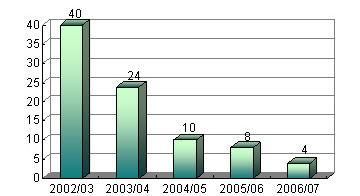
Number of Noise Abatement Notices Received
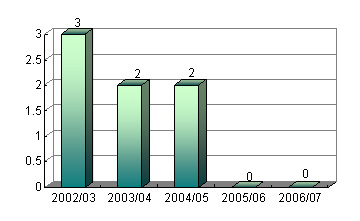
With increasing energy demand and the associated environmental impact, the Housing Authority (HA) has consciously worked towards reducing energy use in our operations, especially in our headquarters, offices and in public areas of the Public Rental Housing estates, as well as enhancing the energy efficiency of our new projects.
Energy Targets 2006/07 |
Performance |
Reduce electricity consumption of landlord services installation in new domestic blocks by adopting Energy Codes and obtaining energy certificates for completed projects. |
Fully Met |
Explore and study application of more energy efficient equipment by completing trial installation of solar powered lamp poles, adjustment of lift counterweight settings and adopting a wider use of T5 fluorescent tubes. |
Fully Met |
Explore and study application of green design for building services equipment. |
Fully Met |
Reduce energy consumption of shopping centres with central air conditioning system by shortening operating hours of the air conditioner and lighting and undertaking initiatives to enhance staff awareness of energy savings. |
Fully Met |
Reduce energy consumption for office premises by performing various energy saving initiatives. |
Fully Met |
Energy Consumption
In 2006/07, electricity consumption by our headquarters, offices and all our premises was
643 992 838 kWh, 0.85% less than 2005/06.
The percentage breakdown of electricity consumption by the HA's different premises is given below.
Composition of Total Electricity Consumption in 2006/07
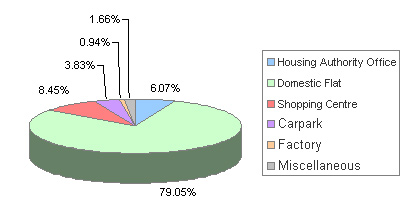
Electricity consumption in the public areas of our estates accounted for the highest proportion (about 79%) of our annual electricity consumption. The HA carried out several large-scale energy saving exercises in 2002/03 and 2003/04 that improved energy efficiency dramatically in those years. Compared to 2005/06, energy consumption for public areas in 2006/07 slightly increased from 68.9 kWh to 69.4 kWh per flat per month. This was due to the fact that new buildings with more electrical installations have been developed.
Energy Consumption in Public Area of Estates (kWh per flat per month)
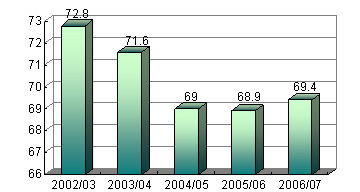
Renewable Energy and Energy Efficiency
The efficient use of energy in our buildings is a key factor in our efforts to pursue sustainable practices in the provision of housing. Energy consumption in our offices was 40.38 million kWh from April 2006 to March 2007, representing a reduction of 7.88% compared to consumption in 2005/06. In addition to gaining a certificate for our energy saving initiatives under the Hong Kong Energy Efficiency Registration Scheme, we also took the initiative to submit our buildings for assessment under 'BEAM', the Hong Kong Building Environmental Assessment Method, which assesses the performance of the buildings under comprehensive environmental assessment criteria.
Annual Electricity Consumption in Housing Authority offices (kWh in millions)
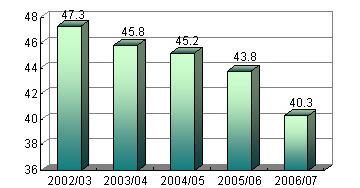
In 2006/07, the HA installed T5 fluorescent tubes at Fanling Area 36 Phase 3 public housing management offices and emergency exit signs at the Lee Yue Mun Phase 2. The use of T5 fluorescent tubes is expected to cut energy consumption by 30% compared that of the ordinary T8 fluorescent bulbs.
To reduce energy consumption in shopping centres, timers have been adjusted to shorten the operating hours of the air conditioning systems for five shopping centres including On Kay Court, Kwai Chung, Hoi Lai, Tin Yan, and Mei Tin. Energy saving measures are also included in circulars and discussed at frontline management meetings to enhance staff awareness.
In line with our energy management policies to conserve energy wherever possible, during the year, we have continued to reduce the use of artificial lighting in areas where daylight provides sufficient illumination.
Apart from the installation of energy efficient products for electrical, lighting and lift installations, we have been actively involved in exploring the benefits of solar power and the potential for their use in various external lighting schemes. We have successfully adopted the use of a solar panel mounted on a rooftop to power two light fittings at a Shatin estate, and two solar-powered lamp posts in an estate in Fanling area. In the redevelopment project of Lam Tin Phases 7 and 8, which commenced in 2006, a solar photovoltaic system has been incorporated into the design, to be located on the roofs of some domestic blocks and on top of the covered walkways to supplement the power supply for some communal facilities. The redevelopment project is scheduled for completion in 2009.
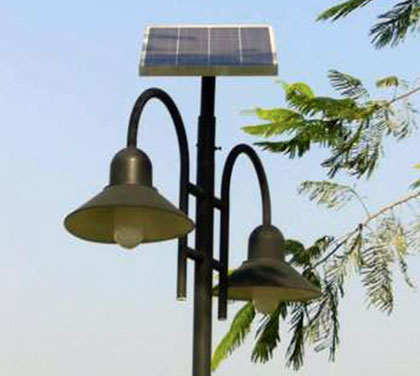 |
|
| Solar Panels Installed for External Lighting | |
As one of the largest players in the Hong Kong construction industry, the Housing Authority (HA) is promoting the need to implement effective waste management by its business partners and following the 4Rs principles: Reduce, Reuse, Recycle and Recover.
Our efforts in waste management at residential properties and in our offices have focused on facilitating the collection and recovery of domestic waste for recycling.
Waste Targets for period 2006/07 |
Performance |
Reduce construction and demolition (C&D) waste and ensure proper disposal by developing a Construction Waste Index through conducting surveys of C&D waste. |
Fully Met |
Increase domestic waste recovery rate for paper. |
Fully Met |
Increase domestic waste recovery rate for aluminium cans. |
Fully Met |
Increase domestic waste recovery rate for plastic bottles. |
Fully Met |
Increase domestic waste recovery rate for used clothes. |
Fully Met |
Reduce domestic waste to 0.7326 kg per person per day. |
Substantial progress |
Implementation of waste separation at source programme in all estates by phases. |
Fully Met |
Reduce A3 and A4 paper consumption in all Housing Department (HD) offices by performing various initiatives to reduce paper consumption. |
Fully Met |
Collect waste paper in all HD offices and implement various initiatives to encourage paper recycling. |
Fully Met |
Use environmentally friendly paper in printing of all publicity materials (except sales and marketing publications) by implementing its use as a pre-requisite in all printing jobs. |
Fully Met |
Wastewi$e Scheme
The Wastewi$e Scheme is a programme to help Hong Kong businesses reduce waste generated on their premises or through their services and products, by setting targets and benchmarking their commitment to waste reduction.
Following assessment by the Environmental Protection Department (EPD) and the Hong Kong Productivity Council, the HA has achieved another year of 'Gold Wastewi$e Logo' accreditation.
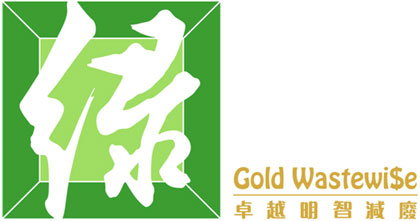 |
|
| Wastewi$e Logo | |
Construction Waste
To reduce the amount of construction waste associated with our operations, we had an Environmental Procurement Policy to address the aspects such as the choice of renewable, recyclable or environmental-friendly building materials. We have also undertaken a Life Cycle Assessment and Costing Study of building materials to select those that reduce environmental impact and long-term costs. We encourage simple designs and the use of building materials that are long-lasting and can be easily maintained.
As of 2002, we have required all of our contractors to adopt a comprehensive Environmental Management Plan on site. We stipulate that contractors must separate construction wastes into inert/ non-inert material for recycling as much as possible. The Construction Waste Index has been implemented in building contracts to ensure the measurement of the quantity of C&D waste generated. In general our contractors have carried out proper on-site sorting and have reduced the quantity of C&D material/waste compared with previous years for sites of similar nature.
Domestic Refuse Production
According to our Waste Reduction Credit Scheme records, on average our residents generated 0.735 kg /capita day of domestic waste in 2006/07 compared to 0.74 kg and 0.78 kg in 2005/06 and 2004/05, respectively.
Improvements in Residents' Daily Domestic Refuse Generation
(kg per person per capita day)
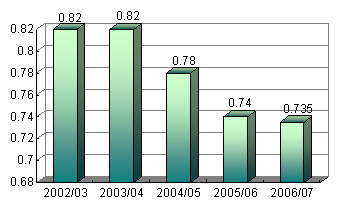
Domestic Waste Recovery
The following table presents the amount of waste recovered for recycling in Public Housing Estates in 2006/07.
| Quantity of Waste Recovered for Recycling | ||
Waste |
Quantity recovered (tonnes) | Percentage recovered |
Paper |
13,025.1 | 12.3 |
Aluminium |
267.7 | 28.3 |
Plastic bottles |
503.3 | 6.2 |
Used clothes |
561.5 | 6.8 |
The recovery rate for paper is similar to that of 2005/06, whilst there has been a significant increase in aluminium can and plastic bottle recovery. According to EPD records, 269.44 kg of rechargeable batteries were recovered from the Housing Department from April 2006 to March 2007. A scheme on waste separation at source has been implemented since 2005/06 in 60 estates.
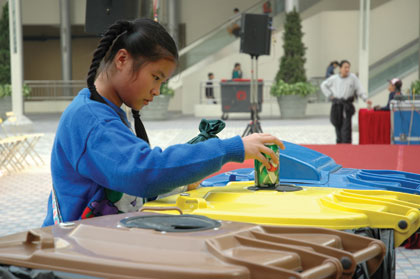 |
|
| Collection Facilities for Recyclables | |
Office Paper Recovery
In 2006/07, there was a 1.95% reduction in A3 and A4 paper consumption in HA offices. The amount of waste paper collected from April 2006 to March 2007 was 169 993 kg., an increase of 5.36% as compared to that of 2005/06. Apart from publicity materials, all paper used by the HA for printing is made of recycled paper.
Improvements in Waste Paper Collection in Housing Authority Offices (kg)
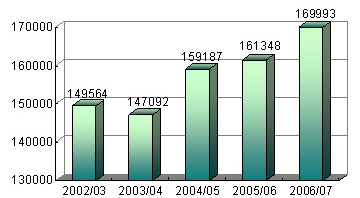
Waste Related Complaints
In 2006/2007, we received two complaints on our contractors regarding fly-tipping of construction waste. These complaints have been followed up by the contractors and closed out.
Control of Hazardous Materials
A target has been set for the past year on the control of hazardous materials with a particular concern on asbestos removal works.
Control of Hazardous Materials Targets |
Performance |
Further abate the remaining asbestos-containing materials in existing Housing Authority managed properties by implementing an asbestos abatement programme through estate redevelopment programmes and asbestos removal works. |
Fell Short |
Asbestos Removal
A performance target to achieve 1.5% asbestos removal measured in terms of demolition of pre-1986 blocks has been set. Due to adjustment of demolition progress, up to March 2007, asbestos removal has been carried out at five blocks at Cheung Sha Wan Flatted Factory and four blocks at San Po Kong Flatted Factory, representing only 0.9% of removal for the blocks.
Disposal of Mercury from Spent Flourescent Tubes
Mercury-containing lamps are often used in Public Rental Housing; these include all flurorecent lamps and high intensity discharge lamps. Since the release of mercury from broken lamps can contaminate the environment and create health hazards through inhalation or skin contact, we dispose of such items with care and in accordance to the Environmental Protection Department's Guidelines and the Waste Disposal (Chemical Waste)(General) Regulations were applicable. Appropriate measures include proper sealing, packaging, labeling and storage of packaged mercury-containing lamps. ![]()
Material Usage
A target has been set for the past year on material usage with particular encouragement on the use of softwood timber doors.
Material Usage Targets |
Performance |
Use of softwood timber doors in Public Rental Housing (PRH) estates |
Fully Met |
A target has been set for the use of softwood timber doors in PRH estate in 2006/07 as softwood timber is a sustainable option. We are monitoring the performance in one of our pilot project commenced in June 2006. The research and project teams visited two factories in China in December 2006 manufacturing products with Forest Stewardship Council certified timber. The pilot project will be completed in October 2009.
In the past year, we have continued to insist our contractors use reusable metal hoardings, metal formwork and prefabricated building elements. As a result, in the past year we were able to avoid the use of 10 780 tonnes of timber.
We have continued our use of pulverized fuel ash (PFA) as a partial cement substitute on our construction sites. In 2006/07, our use of PFA saved 15 600 tonnes of cement use.![]()
We continually keep track of our contractors' performance through site inspections. In 2006/07, no environmental non-compliance incidents were recorded.
Number of Environmental Convictions against Housing Authority Construction Sites
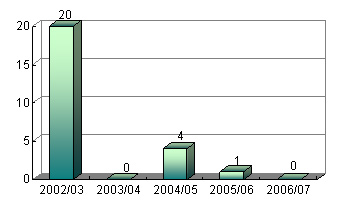
Case Study: Microclimate Studies
Microclimate studies were first employed in 2001 in the development of site-specific layout plans and building designs for our housing estates. Since 2004, this revolutionary concept was then applied to all projects in the planning and design stage and in a bid to create a healthy, environmentally friendly and sustainable living environment for tenants. Using sophisticated computer simulation models with the application of computational fluid dynamics, these studies provide details of a site's overall environment and surroundings, such as wind speed, air flow, daylight angle, shading area, heat generation and retention, traffic noise and the dispersion of pollutants of individual sites. The results provide information for designers to determine the best disposition, location and orientation of individual buildings, as well as the best utilisation of the site. These factors are then taken into consideration in refining the design of the development to create an environment where the use of natural daylight, cross ventilation and the flow of air, as well as the dissipation of heat and pollutants, are optimised to create a more pleasant, clean and green environment for residents. The studies also enable the planning of the most suitable areas for outdoor activities within the estates and the planting of greenery to achieve the greatest benefits in the moderation of temperatures, the provision of shade and the protection against wind. Designers can thus optimise the development potential of our sites without any "wall effect".
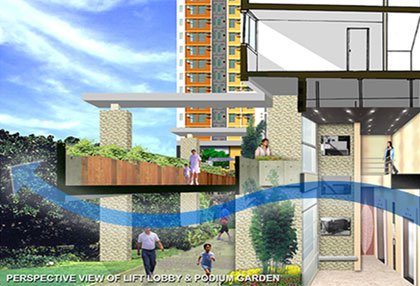 |
|
| Urban greening design approach with enhancement of building permeability | |
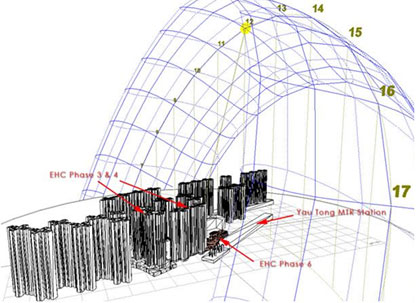 |
|
| Using Stereographic Sun Path Diagram to Plan for External Layout | |
With the microclimate data, we can also custom-design environmentally friendly precast facades for each flat with glazing, ledges, fins and other features that address orientation, sun-penetration, wind direction and noise abatement. These are now being implemented in a number of pilot projects. With the incorporation of these key elements into the building designs, our tenants can enjoy a comfortable and healthy environment with an optimum level of natural daylight and ventilation in their flats ultimately leading to reduced energy consumption and cost.
The Upper Ngau Tau Kok Estate Redevelopment Phase 2 and 3, which is scheduled for completion at the end of 2008, is the first estate that has adopted microclimate studies in its design. All new estates due for completion with effect from 2009, will benefit from the application of microclimate studies.
This novel concept has been followed with interest in the building industry. The Planning Department has also mandated the requirement of Air Ventilation Assessment at prescribed sites. This Housing Authority initiative won the Hong Kong Institute of Architects' Special Architectural Award for Architectural Research in 2006 and a merit award at the Hong Kong Institute of Planners Award 2007.
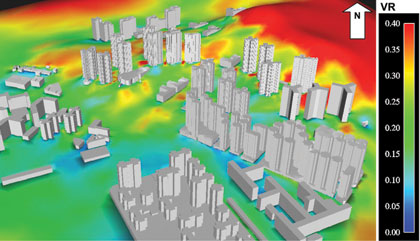 |
|
| Air Ventilation Assessment Study for Choi Wan Road Housing Development | |